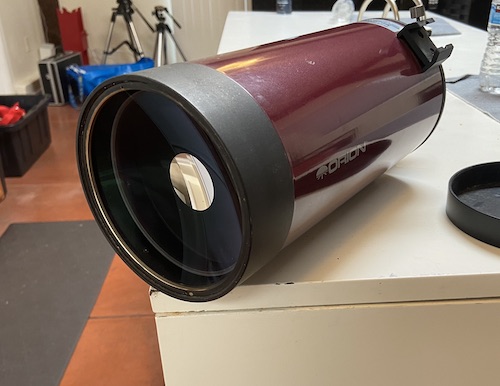Orion’s Apex 127 is sold primarily as a spotting scope, but it’s identical to the “astronomical” 127mm Maksutov-Cassegrains sold by Orion and other brands. If you don’t mind the hassle of upgrading the accessories and choosing a mount for it, the Apex 127 really is an excellent telescope.
Overview Of Apex 127mm

As with all of Orion’s 5” and smaller Maksutov-Cassegrains, the Apex 127 comes with an extremely aesthetically pleasing powder coat finish with a pretty ruby-red colouration – why they don’t do this with their 6” and 180mm optical tubes I do not know.
The Apex 127 has an undersized primary mirror around 120mm (4.72”) across, which makes it half an f-stop slower – f/12.5 vs the f/12 advertised. This is the same as Orion’s StarMax 127, Celestron’s NexStar 127SLT, and the “127mm” Maksutov-Cassegrains sold by Sky-Watcher, as well as any other 127mm f/12 Maksutovs out there.
I wish Orion and the other manufacturers who sell this same telescope could just be honest about this because it’s still a nice telescope otherwise. With 120mm of aperture, you can see a lot of detail on the Moon and planets and do a fair amount of serious deep-sky viewing – though the long 1500mm focal length and nominally 1.25”-only accessories limit the wide-field capabilities of this instrument.
Being a Maksutov-Cassegrain, the Apex 127 seldom needs collimation – though the rear cell has screws if you ever must do so. The optical quality of the Apex, like most Maksutovs, is superb. It is great for lunar, planetary, and double star viewing.
The Apex 127 focuses with the same moving-mirror system most catadioptrics use, and comes with a Maksutov-thread visual back, though you can buy an adapter to use Schmidt-Cassegrain threaded accessories. The 1.25” visual back included has built-in T-threads to attach your DSLR camera. Attaching an SCT-thread adapter and a 2” SCT diagonal will result in some vignetting with wide-field eyepieces thanks to the scope’s narrow baffle tube and undersized primary mirror, but you can still use them to some extent.
Like most telescope optical tubes, the Apex 127 has a Vixen-style dovetail bar with ¼ 20 holes attached so you can either attach it to a Vixen-compatible mount or a heavy-duty photo tripod.
Accessories
As it is sold primarily as a spotting scope and not an astronomical telescope for some reason, the Apex 127 is supplied with a 45-degree erecting prism diagonal. Not only is the 45-degree angled design rather uncomfortable for astronomical use, but the cheap erecting design results in scattering and light loss. You really should replace it with a 90-degree prism or dielectric mirror star diagonal if you plan on using the Apex 127 for any astronomical viewing.
Additionally, the Apex 127 includes an erect-image, straight-through 6×26 finderscope. Like the 45-degree diagonal, it’s really only useful for terrestrial spotting, as the erecting design sucks up a fair amount of the already paltry 26mm of aperture. A quality 6×30 – or even better, 9×50 – straight-through or right-angle finderscope would be much better, and for a primarily planetary/double-star orientated telescope like the Apex a red-dot or reflex sight finder would also work just fine. You can easily swap in a new finder thanks to the StarMax’s industry-standard interchangeable, quick-release finderscope base.
The Apex 127 comes with one eyepiece: A 25mm Sirius Plossl providing approximately 60x (the moving-mirror focusing system results in a slight deviation from the advertised focal length of the telescope depending on what diagonal/eyepiece combination you use). This is fine for low-medium power, but a 32mm or 40mm Plossl eyepiece would probably be better for the lowest-power use and you’ll want at least a couple short focal length eyepieces for high power, where the Apex 127 really excels.
Lastly, the Apex 127 includes a nice soft carrying case for transporting it, a convenient additional touch. The case has just enough room for you to stow a few additional small accessories such as a diagonal, finderscope, and eyepieces, and it’s strong enough to withstand a fair amount of use.
Astrophotography Capabilities Reviewed
The StarMax’s f/12.5 focal ratio doesn’t really lend itself well to astrophotography. A few of my friends and acquaintances have actually done some impressive pictures of the Orion Nebula and some other bright targets with this telescope, but it required an extremely heavy-duty mount and accurate autoguiding in addition to very long exposure times – a fast Newtonian or ED refractor is much, much better for deep-sky astrophotography.
The StarMax 127 does do a pretty good job for lunar and planetary astrophotography. With a 2x Barlow, a mount with motorised tracking, and a webcam-style CCD like the ZWO ASI120 or a Celestron NexImage series camera, you can get high-resolution images of the Moon and planets and amaze your friends and family, in addition to tracking planetary weather patterns and other phenomena.
Mounting Recommendations
At 8.6 pounds/3.9 kilograms, the Apex 127 is heavy enough that it demands a quality mount, particularly for the high-magnification use it is primarily designed for. An EQ-3 class mount like the Orion AstroView will certainly hold it, but an EQ4 mount like the Celestron CG-4 or Orion SkyView Pro would be even better. An alt-azimuth mount like the Explore Scientific Twilight I or Orion VersaGo II would also work fabulously and is a more convenient and lighter-weight option than an equatorial mount.
If you’re planning on doing astrophotography, plan on obtaining one of the aforementioned equatorial mounts and attaching a motor drive to it.
Conclusion
At the price it commands, the Orion Apex 127 really is a steal if you want a convenient, travel-friendly and portable telescope with enough aperture for some serious viewing.
Don’t let the terrestrial-use marketing or the trouble of having to pick your own mount and accessories scare you.
